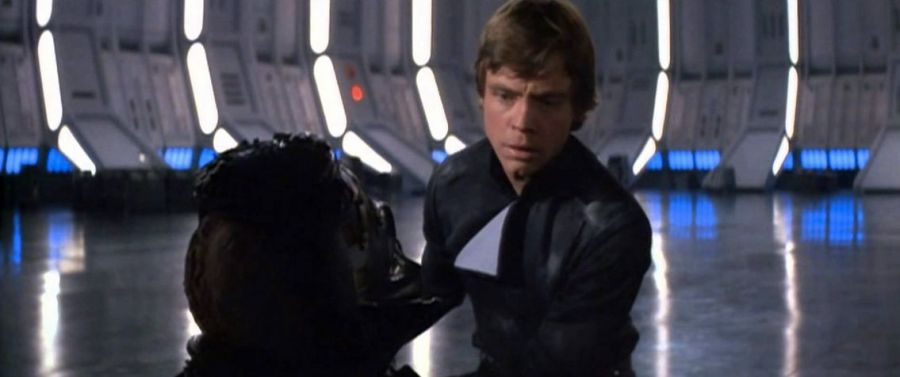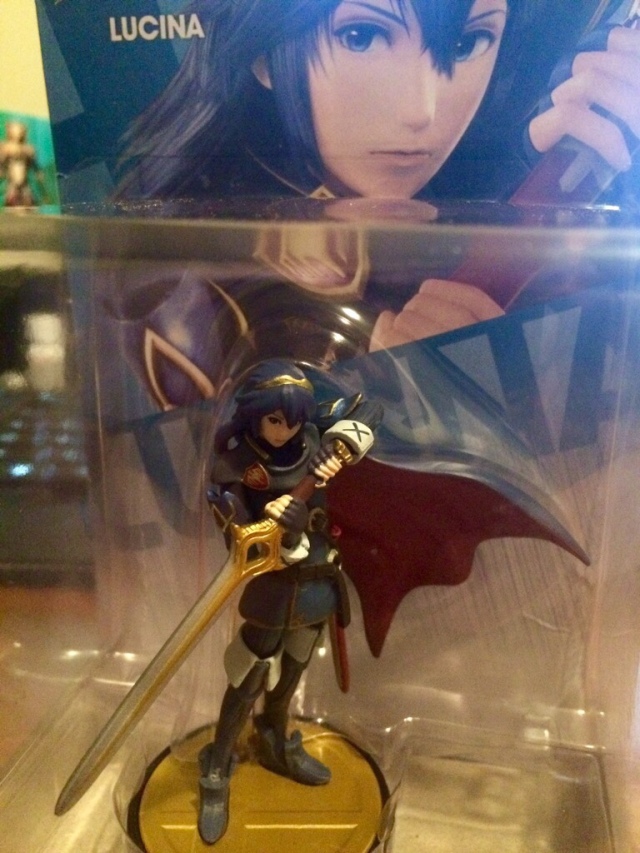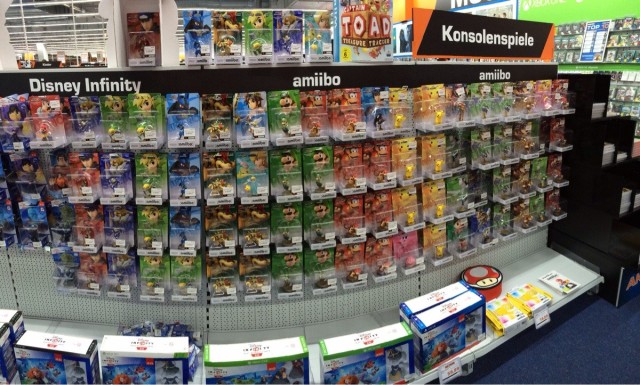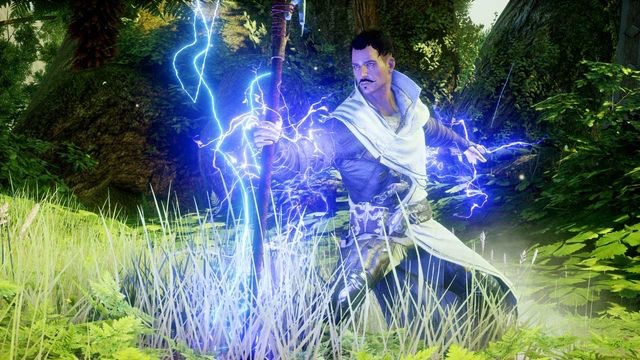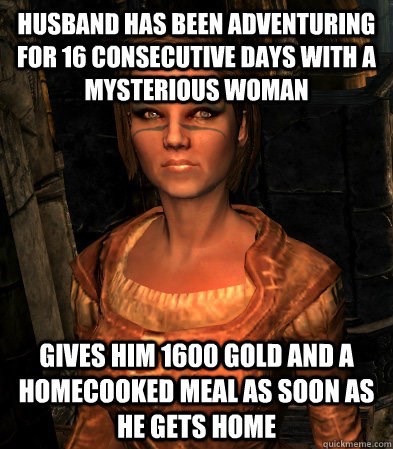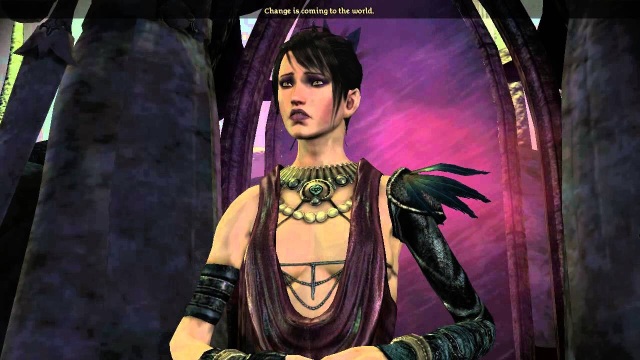We’re less than a fortnight away from the first movie in the long-heralded Star Wars “sequel trilogy” (also the first in the post-Lucas Disney era) and speculation is running wild. Fans are nitpicking every frame of every trailer for clues. One theory which has picked up speed in the last month comes from Rob Conery, who proposes that Return of the Jedi does not show us the ultimate bittersweet victory of Luke Skywalker but rather the tragic fall of the saga’s hero to the Dark Side of the Force.
You can read Conery’s thoughts here. MatPat of Game Theory & Film Theory summarizes the theory beautifully here, as well.
In short, the “Luke Turns” Theory (as I call it) suggests that Luke’s decision to leave Yoda and his traumatic battle with Vader in The Empire Strikes Back start him on the path to the Dark Side. His actions in Return of the Jedi set the stage for his fall, and the machinations of Emperor Palpatine finally bring him to the path of the Sith. Luke comes to desire the promise Vader offered, that he could “rule the galaxy as father and son,” but he has that chance taken away with Vader’s death; he ultimately succumbs to hatred for nothing.
To think our intrepid hero could have become a villain can be jarring. Was Conery on to something, though?
Before the Duel
When we first see Luke at the beginning of Jedi, he’s dressed in black and has a confident, even arrogant air about him. He threatens Jabba, pushes his guards with the Force, and even barters with his friends’ lives. It’s a far cry from the mopey Skywalker we saw in A New Hope or the brave front he put on in Empire.
We’re programmed to associate dark attire like his new robes with villains, or at least antiheroes of questionable allegiance. It could be construed as a clue to his fate – or it could just signify his inner turmoil and despair at the bleak state of the Rebellion. He lost his hand, his best friend is trapped in carbonite, his mentor is dead, and he’s just had his world shattered by the news of his father’s true identity. Luke’s had a hard go; surely we can let him tap into his angsty side.
The persona he shows to Jabba is not entirely unbecoming of a Jedi, either. The Hutt is not an opponent to be underestimated. If he shows any sign of weakness, the entire plan could be ruined. Furthermore, we’ve seen other Jedi act this condescending to others on a handful of other occasions.
When looking for proof of Luke’s fall, these instances can seem like foreshadowing – and yet they don’t mean much.
Intent vs. Final Product
One of the cornerstones of this theory is the original outline for Jedi as devised by George Lucas and Gary Kurtz. During the outlining phase, the film was meant to be radically different – Han died, Leia struggled with her new leadership duties, and Luke became an ambivalent gunslinger archetype. Lucas eventually changed this angsty conclusion for the happy little bow of an ending we know now, dreading the cut the dark tone could hurt the series’ lucrative toy sales.
It should also be noted, I think, that in one of these early drafts Obi-Wan was supposed to remanifest in a corporeal form, literally willing himself back to life to help finish the fight against Vader. These unpolished outlines sound … really bad. There’s a reason stories go through several drafts. Jedi‘s ending, as shown, is undeniably hokey, but at least the final product has a sense of closure that doesn’t undercut much of the saga.
Parts of this original intent, however, survived in the final product. Hamill has stated before (including one round-table conversation with Kevin Smith and J.J. Abrams, director of The Force Awakens) that he thought this was a much more interesting end to Luke’s story, and when you watch Jedi through the lens of this theory you can see him tapping into this idea during the climactic battle.
The Truth of Battle
Whatever the original drafts or moments of foreshadowing suggest, the true deciding moment is the battle between Vader and Luke, father and son. (You can watch the whole showdown here, without the other storylines getting in the way.)
The fight proper begins when Luke makes an attempt on Palpatine’s life. On one hand, taking another’s life deliberately can be seen as an evil, un-Jedilike action. Yet again, this is the big evil mastermind of the series that he tries to kill. Any evil in talking Palpatine’s life is drastically worth the lives saved by removing him from the galactic equation. This is a move for the greater good, and we cannot consider this a move toward the Dark Side.
Throughout the first phase of the fight (before he tries to hide), Luke is noncommittal. Luke’s more interested in talking his father back to the Light than in actually fighting him. He isn’t on the slippery slope just yet. It takes a threat on Leia’s life and soul to bring out Luke’s rage.
In the second phase of the fight, Luke fights like a proper Sith Lord. From the moment he cries “never,” he is on the offensive with the upper hand. Once he gets his father against the railing he really taps into that anger – look at the way he hammers against Vader’s saber until his guard breaks and (literally) disarms (dishands?) his foe.
There’s no refuting that Luke is flirting with the Dark Side here. To act in rage (or, really, in any form of impassioned emotion) is to forsake the path of the Jedi for the path of the Sith, and there’s no emotion more suited for the dark side than rage, hate, anger. In that, the theory holds absolutely true. This is the closest Luke has come to the evil side of the Force.
He realizes what he’s doing, however, and stops himself – a very Jedi-like action. Luke puts on the brakes as the cliff approaches. Of course, this sets the stage for Palpatine’s signature Force Lightning and a conclusion that cuts the head off the Empire and removes both of his would-be Sith tutors.
If Luke is truly turning to the Dark Side in this battle, why does he refuse to kill his father? He uses his hate only to subdue the threat Vader poses, but cannot finish the deed in cold blood.
Conery suggests that Luke wants to take Vader up on his offer to “rule the galaxy as father and son.” He needs his father alive to teach him the ways of the Force, and Palpatine is a threat to them both, as well as his friends down on the forest moon of Endor. Palpatine realizes what’s going on – that he’s set up an alliance between the Chosen One and his son – and tries to neutralize the threat Luke poses. Here the theory paints Luke as a pretty diabolical figure, sustaining the effects of Palpatine’s Force Lightning but playing on his father’s emotions to save him. Not only has Luke turned, but he’s also quickly adapted the diabolical practices of the Sith.
You can see support for this in Vader’s funeral scene, where Luke sullenly watches the flames and smoke rise into the night. The average viewer sees the hero mourning the father he saved but never truly knew, but Conery sees the newly turned villain mourning a father-son alliance that could have brought the galaxy to its knees. Thanks to Hamill’s performance, either reading of the scene is valid.
There are some holes in Conery’s theory here, however. Anakin, with his last few breaths, claims that Luke has done well and saved him before the end of his life. If Luke was truly bummed that he couldn’t take over the Empire with his father, perhaps this would have been a better time to lament the lost opportunity – “we could have ruled together, father!” or something to that effect .Instead they sadly celebrate the redemption of Anakin Skywalker in those few fleeting moments they have together. There is no bitter vow to finish the evil works he set in motion. Furthermore, Luke is later visited by the spirits of Yoda, Obi-Wan, and Anakin (Christensen or Shaw, depending on your preference), who show their spectral approval. If Luke has indeed embraced the dark side now, perhaps his mentors, who now dwell in the very essence of the Force itself, would sense the change in him and do more than stand by to watch the festivities. Granted, Obi-Wan and Yoda never saw the threat Palpatine posed back in the Republic…
Only a Sith Deals in Absolutes
So Conery’s theory has some legs, although they’re more contravened by the actual print of the film. If one holds to the theory, one is left to cite revised intentions and interpretations of Hamill’s performance for support. Abrams may yet turn Luke Skywalker into a villain, but for now there’s very little concrete evidence to stand on. It’s clear that Lucas did not ultimately intend this interpretation, and yet there are debatable grounds for it.
I contend that we can apply some conditions to the arguments for and against the Luke Turns Theory, at least until the world sees The Force Awakens and we know Luke’s true fate (and his connection to Kylo Ren, if any). Allow me to elaborate.
Consider the tales of Luke Skywalker post-Vader in the Expanded Universe. He establishes an academy on Yavin IV and founds a new generation of Jedi to face ongoing threats to galactic peace. He has countless brushes with the Dark Side akin to the showdown with Vader – as do most of his students. Encountering the evil within either break these new Jedi or make them all the more resolved in their convictions. Luke, for his part, stands firm in his devotion to the Jedi path.
If Abrams does complete Luke Skywalker’s journey to the Dark Side, I suggest we consider the works of the Expanded Universe as two sides of a coin. On one hand, we have the now defunct timeline of the Expanded Universe, or the “Legends” timeline, to follow the new publishing convention – in this timeline, Luke Skywalker remains a good guy and trains the next generation of Jedi (including Jacen and Jaina, the twin children of Han and Leia). We would also have the current Disney canon, validating Conery, where Luke Skywalker is seduced by the Dark Side and does … whatever he’s been up to over the last thirty years. We’d have a Good Timeline and an Evil Timeline (or, to quote Community, a Darkest Timeline). This would appease long-time fans like me who were upset to see years of lore pushed aside unceremoniously.
Do you agree with Conery, Hamill, and Abrams – that Luke falling to the Dark Side is a more powerful conclusion to the saga? Or do you prefer the happy ending Lucas presented? Or are you just too excited about Episode VII to care about anything else right now? Let me know in the comments, or on Twitter!

